Lowrider
A lowrider or low rider is a customized car with a lowered body that emerged among Mexican American youth in the 1940s.[3] Lowrider also refers to the driver of the car and their participation in lowrider car clubs, which remain a part of Chicano culture and have since expanded internationally.[3][4] These customized vehicles are also artworks, generally being painted with intricate, colorful designs, unique aesthetic features, and rolling on wire-spoke wheels with whitewall tires.[3][5]
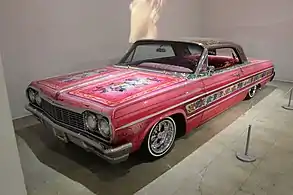
Lowrider rims are generally smaller than the original wheels.[6] They are often fitted with hydraulic systems that allow height adjustable suspension, allowing the car to be lowered or raised by switch. From 1958 to 2023, the California Vehicle Code made lowriding illegal, which was ultimately criticized as unnecessary and discriminatory toward Chicano and broader Latin American culture.[7][8]
| Part of a series on |
| Chicanos and Mexican Americans |
|---|
 |
|
Origin and purpose
The lowrider car serves no practical purpose beyond that of a standard car. Lowrider car culture began in Los Angeles, California, in the mid-to-late 1940s and during the post-war prosperity of the 1950s. Initially, some Mexican-American youths lowered blocks, cut spring coils, z'ed the frames and dropped spindles. The aim of the lowriders is to cruise as slowly as possible, "Low and Slow" being their motto. By redesigning these cars in ways that go against their intended purposes and in painting their cars so that they reflect and hold meanings from Mexican-American culture, lowriders create cultural and political statements that go against the more prevalent Anglo culture.[3]
Legal issues
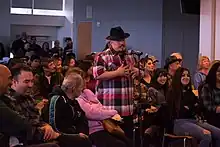
Section 24008 of the California Vehicle Code went into effect on January 1, 1958, prohibiting cars modified to shift the vehicle body lower than the bottoms of its wheel rims. In 1959, mechanic Ron Aguirre bypassed the law by installing hydraulics that could quickly toggle the height of a General Motors X-frame chassis.[10]
Lowriding became widely popular in the 1980s and 1990s, and bans were enacted in many California cities.[11] It regained popularity a little in 2009, then significantly during the COVID-19 pandemic in the United States.[12] In the 2020s, activists argued that the practice was harmless and banning it was simply the result of prejudice against Mexican-Americans.[5] San Jose and Sacramento repealed their bans in 2022 that had been enacted in 1986 and 1988, respectively.[9][11] In 2022, the California State Assembly unanimously passed a resolution urging all remaining cities with bans (including National City, which banned it in 1992) to repeal them.[13] In 2023, California rescinded state restrictions on the height of vehicle bodies and superseded local regulations against cruising.[8]
Adding height adjustable suspension

In 1959, a customizer named Ron Aguirre developed a way of bypassing the law with the use of hydraulic Pesco pumps and valves that allowed him to change ride height at the flick of a switch.[14] Ron Aguirre developed this modification with help from his father, after conceiving of the idea. Aguirre's motivation was to stop being targeted with traffic tickets, as he had been by local police in his city of Rialto, California after the statewide ban was enacted.[7]
Role of the Chevrolet Impala
1958 saw the emergence of the Chevrolet Impala, which featured an X-shaped frame that was perfectly suited for lowering and modification with hydraulics.[14] The standard perimeter-type frame was abandoned, replaced by a unit with rails laid out in the form of an elongated "X." Chevrolet claimed that the new frame offered increased torsional rigidity and allowed for a lower placement of the passenger compartment. This was a transitional step between traditional perimeter frame construction and the later fully unitized body/chassis, the body structure was strengthened in the rocker panels and firewall. This frame was not as effective in protecting the interior structure in a side impact crash, as a traditional perimeter frame.[15]
Lowrider culture
.jpg.webp)
.jpg.webp)
Between 1960 and 1975, customizers adapted and refined GM X-frames, hydraulics, and airbrushing techniques to create the modern lowrider style.[16] Lowriding grew alongside the Chicano Movement in the 1960s and 1970s.[5]
At first, lowriders were only seen in places such as Los Angeles, especially in the 1970s on Whittier Boulevard when lowriding came to its peak. Whittier was a wide commercial street that cut through the barrio of the city in Los Angeles, California. Throughout the 1970s that culture spread throughout the Central Valley and San Jose areas of California, helped by release of the R&B song “Low Rider” by War, and creation of low riding clubs such as Carnales Unidos in 1975,[17] and further expanded with the publishing of Low Rider magazine by San Jose State students in 1977.[18] At its peak in 1988, Low Rider magazine had monthly sales of over 60,000 copies. Lowriders were featured in the 1979 film Boulevard Nights, which some blamed for associating lowrider culture with street gangs. The lowriding scene is diverse with many different participating cultures, vehicle makes, and visual styles. The city of Española, New Mexico became a hotspot for lowriders outside of California.[4]
Japan
Lowriding culture has also spread to Japan.[19][20]
Junichi Shimodaira continues to import and sell these cars through his business, Paradise Road.[21] The spread of lowrider culture and the fame of Paradise Road even attracted the attention of Ed Roth, who is famous for creating custom cars such as hot rods and a prominent figure in Kustom Kulture.[22] Since the introduction of lowriders in Japan and the rise of lowriders in Japan in 2001, it is estimated that there are still 200 car clubs that are related to the lowrider scene that are still active to this day.[23]
In popular culture
In the 1990s, low riders became strongly associated with West Coast Hip hop and G-Funk culture. Mack 10, Dr. Dre, Snoop Dogg, Game, Warren G, South Central Cartel, Eazy-E, Above the Law and John Cena (In a music video of "Right Now") among others featured low riders prominently in their music videos.[24]
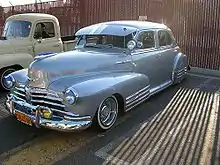 1948 Chevrolet Fleetline lowrider "bomb"
1948 Chevrolet Fleetline lowrider "bomb"- Test of a 1964 Chevrolet Impala hydraulic system
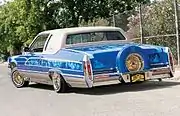 1988 Cadillac Fleetwood Brougham lowrider
1988 Cadillac Fleetwood Brougham lowrider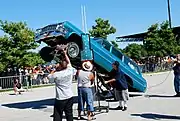 Chevrolet wagon lowrider equipped with hydraulic suspension hopping
Chevrolet wagon lowrider equipped with hydraulic suspension hopping.jpg.webp) A 1994 Cadillac Fleetwood lowrider 3-wheeling during the Fiestas Patrias Parade, South Park, Seattle, Washington
A 1994 Cadillac Fleetwood lowrider 3-wheeling during the Fiestas Patrias Parade, South Park, Seattle, Washington.jpg.webp) 1991 GMC Sonoma pickup modified in the lowrider style
1991 GMC Sonoma pickup modified in the lowrider style
See also
- Lowrider bicycle
- Chicano Rap
- Gangsta Rap (album) which includes the track: Ridin' Low
- G funk
- Kid Frost
References
- "Gypsy Rose, the Most Famous Lowrider of Them All, Goes to Washington D.C." MotorTrend. June 13, 2017. Retrieved January 26, 2023.
- "Lowrider fans pay their final respects to owner of Gypsy Rose in East LA". ABC7 Los Angeles. Retrieved January 26, 2023.
- Sturken, Marita; Cartwright, Lisa (2009). Practices of Looking: An Introduction to Visual Culture. Oxford University Press. p. 80. ISBN 978-0-19-531440-3.
- Tatum, Charles M. (September 5, 2017). Chicano Popular Culture, Second Edition: Que Hable El Pueblo. University of Arizona Press. p. 230. ISBN 978-0-8165-3652-8.
- PBS NewsHour. California ends cruising ban that targeted Chicano low-rider culture, retrieved January 27, 2023
- Stavans, I.; Augenbraum, H. (2005). Encyclopedia Latina: history, culture, and society in the United States. Grolier Academic Reference. p. 51. ISBN 978-0-7172-5818-5. Retrieved January 9, 2020.
- "Ron Aguirre's 1956 Chevrolet Corvette - The X-Sonic - Kustomrama". kustomrama.com. Retrieved January 27, 2023.
- Hernandez, Jose (October 17, 2023). "Once Harassed by Police, Lowriders Can Cruise Across California Under a New Law". NPR. Retrieved October 22, 2023.
- "Cruising in National City could make a legal comeback in 2023". San Diego Union-Tribune. January 1, 2023. Retrieved January 27, 2023.
- TUNDRA_News. "What Happened To Hydraulics? Nothing. It's Still Here". theTUNDRA. Retrieved January 27, 2023.
- Clift, Theresa (June 6, 2022). "Sacramento Repeals Ban on Lowriding, Rescinding 1988 Law Now Viewed as Discriminatory". The Sacramento Bee. Retrieved October 22, 2023.
- Hernandez, Daniel; Schaben, Allen J.; Chun, Myung J. (May 14, 2021). "The lowrider is back: The glorious return of cruising to the streets of L.A." Los Angeles Times. Retrieved February 16, 2023.
- "State Assembly encourages California cities to repeal cruising bans". KFMB-TV. June 28, 2022. Retrieved January 27, 2023.
- "Going "Low and Slow" in East Los Angeles". The Golden State Company. Retrieved August 24, 2020.
- Niedermeyer, Paul (January 19, 2012). "Automotive History: An X-Ray Look At GM's X Frame (1957 – 1970)". Curb Side Classic. Retrieved February 28, 2015.
- Rong, Blake (July 16, 2016). ""Ghetto Famous" Lowriders Reach For The Sky In Odessa, Texas". Road & Track Magazine. Retrieved August 24, 2020.
- "Carnales Unidos Car Club – Lowrider Magazine". MotorTrend.com. August 6, 2010. Retrieved February 15, 2022.
- "The life and death of Lowrider: How the Chicano car magazine shaped California". Los Angeles Times. December 14, 2019. Retrieved February 15, 2022.
- Frost, Bob. "History of Lowriders". Historyaccess.com. Archived from the original on August 18, 2020. Retrieved April 25, 2018.
- "LOWRIDER HISTORY". Convictedartist.com. Retrieved February 15, 2022.
- Lirones, Brett (February 28, 2019). "Here's Why You'll Find American-Styled Lowriders Roaming Around the Streets of Japan". Hagerty. Retrieved May 5, 2019.
- Mendoza, Beto (November 27, 2014). "Paradise Road - Shop Stop & Talk". Lowrider. Retrieved May 5, 2019.
- Donoghue, JJ. "The Elaborate Customized Cars of Japan's 'Lowriding' Subculture". CNN. CNN. Retrieved May 5, 2019.
- Strait, Kevin. "Lowriders and Hip Hop Culture". Smithsonian. Retrieved August 30, 2021.
Further reading
- Brown, J (2002). "DIPN The Industry of Low Riding", Dream Factory Films, 1(2)(3).